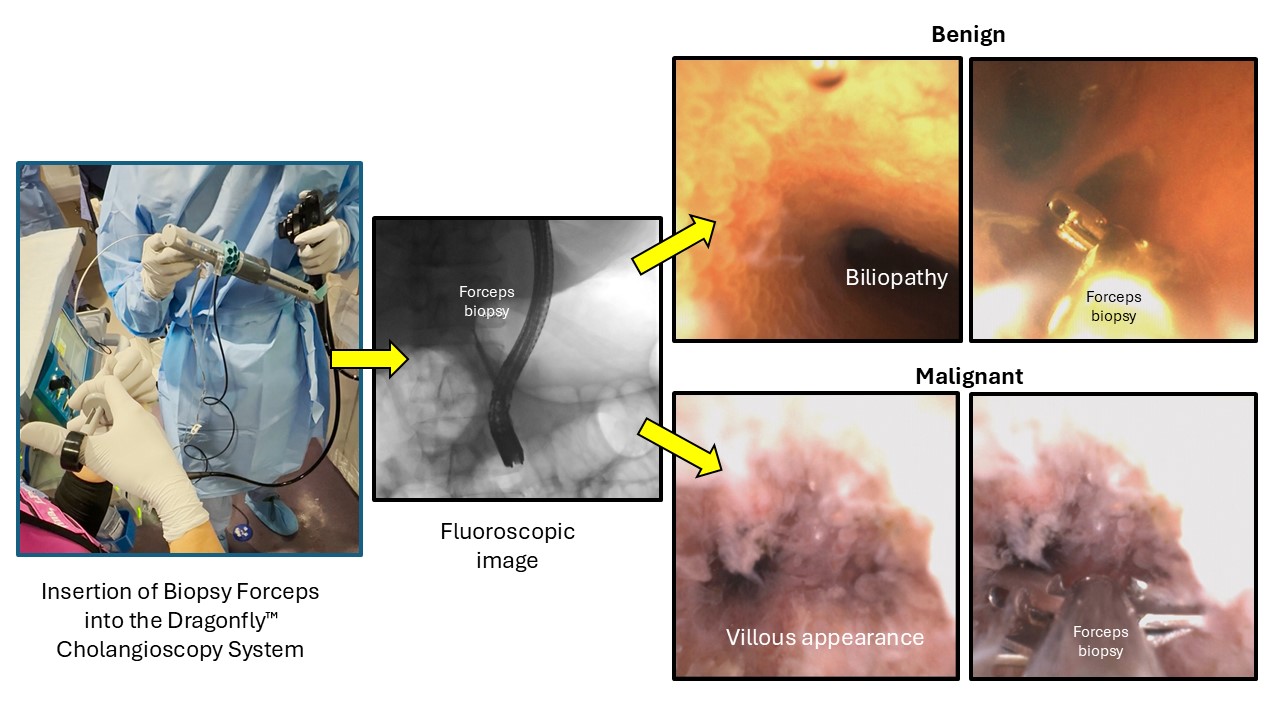Tuesday Poster Session
Category: Interventional Endoscopy
P5714 - Novel Cholangioscopy System With Large Rotating Forceps: A Case Series in the Evaluation of Biliary Strictures
Tuesday, October 28, 2025
10:30 AM - 4:00 PM PDT
Location: Exhibit Hall

Shuji Mitsuhashi, MBBS (he/him/his)
Mayo Clinic
Rochester, MN
Presenting Author(s)
Shuji Mitsuhashi, MBBS, Chinmay Guralwar, MBBS, Elizabeth A. Lemke, MPH, Rishad Khan, MD, Khushboo Gala, MBBS, Vinay Chandrasekhara, MD
Mayo Clinic, Rochester, MN
Introduction: Indeterminate biliary strictures remain a diagnostic challenge. Peroral cholangioscopy (POC) enables direct ductal visualization and targeted biopsies, but traditional platforms are limited by reduced tip maneuverability and narrow working channels that restrict tissue acquisition. The Dragonfly™ POC system was developed to address these limitations, featuring a rotatable tip, enhanced deflection, and a larger working channel that accommodates forceps with a 6 mm open jaw span (compared to 3.95 mm in standard models). While preclinical results have been promising, clinical data remain limited. This case series describes our initial experience using the novel POC system for the evaluation of biliary strictures.
Case Description/
Methods: Five patients (aged 24–62; 1 female) with biliary strictures underwent POC using the novel system at a tertiary center. Procedures were performed by two experienced endoscopists and two supervised trainees. Cholangioscopic findings were assessed for malignant features, including mucosal irregularity, nodularity, villous projections, and neovascularization. Targeted biopsies were obtained using large-caliber rotating forceps. Clinical, endoscopic, and histopathologic data were reviewed.
POC was technically successful in all five cases. Device performance was rated using a 5-point Likert scale (5 representing the best score). Median scores were 4 for pushability into the duct, 4 for tip control, 5 for device passage, and 4 for image quality. Four patients had findings concerning for malignancy. Of these, three had cholangiocarcinoma confirmed with biopsies; standard-of-care brush cytology in these cases was “suspicious for adenocarcinoma” but non-diagnostic. The fourth case had biopsy-proven hepatocellular carcinoma with biliary invasion, but brush cytology again was non-diagnostic, reporting only “atypical cells.” One patient with portal biliopathy had benign findings both visually and histologically. Specimens were diagnostically adequate in all cases (mean size 0.12 ± 0.07 cm²). No periprocedural adverse events occurred, and all patients were discharged safely.
Discussion: This initial experience suggests that the novel POC system is a feasible and effective tool for evaluating biliary malignancy. In all cases, POC-guided biopsy yielded sufficient tissue for accurate histologic diagnosis, whereas brush cytology was non-diagnostic in all four malignant cases.

Figure: Figure 1. Cholangioscopy-Guided Targeted Biopsy Using the Dragonfly™ System:
Sequential images show forceps insertion into the novel system, fluoroscopic confirmation of intraductal positioning, and endoscopic views of benign (biliopathy) and malignant (villous appearance) strictures. Targeted biopsies correlated with visual impressions.
Disclosures:
Shuji Mitsuhashi indicated no relevant financial relationships.
Chinmay Guralwar indicated no relevant financial relationships.
Elizabeth Lemke indicated no relevant financial relationships.
Rishad Khan indicated no relevant financial relationships.
Khushboo Gala indicated no relevant financial relationships.
Vinay Chandrasekhara indicated no relevant financial relationships.
Shuji Mitsuhashi, MBBS, Chinmay Guralwar, MBBS, Elizabeth A. Lemke, MPH, Rishad Khan, MD, Khushboo Gala, MBBS, Vinay Chandrasekhara, MD. P5714 - Novel Cholangioscopy System With Large Rotating Forceps: A Case Series in the Evaluation of Biliary Strictures, ACG 2025 Annual Scientific Meeting Abstracts. Phoenix, AZ: American College of Gastroenterology.
Mayo Clinic, Rochester, MN
Introduction: Indeterminate biliary strictures remain a diagnostic challenge. Peroral cholangioscopy (POC) enables direct ductal visualization and targeted biopsies, but traditional platforms are limited by reduced tip maneuverability and narrow working channels that restrict tissue acquisition. The Dragonfly™ POC system was developed to address these limitations, featuring a rotatable tip, enhanced deflection, and a larger working channel that accommodates forceps with a 6 mm open jaw span (compared to 3.95 mm in standard models). While preclinical results have been promising, clinical data remain limited. This case series describes our initial experience using the novel POC system for the evaluation of biliary strictures.
Case Description/
Methods: Five patients (aged 24–62; 1 female) with biliary strictures underwent POC using the novel system at a tertiary center. Procedures were performed by two experienced endoscopists and two supervised trainees. Cholangioscopic findings were assessed for malignant features, including mucosal irregularity, nodularity, villous projections, and neovascularization. Targeted biopsies were obtained using large-caliber rotating forceps. Clinical, endoscopic, and histopathologic data were reviewed.
POC was technically successful in all five cases. Device performance was rated using a 5-point Likert scale (5 representing the best score). Median scores were 4 for pushability into the duct, 4 for tip control, 5 for device passage, and 4 for image quality. Four patients had findings concerning for malignancy. Of these, three had cholangiocarcinoma confirmed with biopsies; standard-of-care brush cytology in these cases was “suspicious for adenocarcinoma” but non-diagnostic. The fourth case had biopsy-proven hepatocellular carcinoma with biliary invasion, but brush cytology again was non-diagnostic, reporting only “atypical cells.” One patient with portal biliopathy had benign findings both visually and histologically. Specimens were diagnostically adequate in all cases (mean size 0.12 ± 0.07 cm²). No periprocedural adverse events occurred, and all patients were discharged safely.
Discussion: This initial experience suggests that the novel POC system is a feasible and effective tool for evaluating biliary malignancy. In all cases, POC-guided biopsy yielded sufficient tissue for accurate histologic diagnosis, whereas brush cytology was non-diagnostic in all four malignant cases.

Figure: Figure 1. Cholangioscopy-Guided Targeted Biopsy Using the Dragonfly™ System:
Sequential images show forceps insertion into the novel system, fluoroscopic confirmation of intraductal positioning, and endoscopic views of benign (biliopathy) and malignant (villous appearance) strictures. Targeted biopsies correlated with visual impressions.
Disclosures:
Shuji Mitsuhashi indicated no relevant financial relationships.
Chinmay Guralwar indicated no relevant financial relationships.
Elizabeth Lemke indicated no relevant financial relationships.
Rishad Khan indicated no relevant financial relationships.
Khushboo Gala indicated no relevant financial relationships.
Vinay Chandrasekhara indicated no relevant financial relationships.
Shuji Mitsuhashi, MBBS, Chinmay Guralwar, MBBS, Elizabeth A. Lemke, MPH, Rishad Khan, MD, Khushboo Gala, MBBS, Vinay Chandrasekhara, MD. P5714 - Novel Cholangioscopy System With Large Rotating Forceps: A Case Series in the Evaluation of Biliary Strictures, ACG 2025 Annual Scientific Meeting Abstracts. Phoenix, AZ: American College of Gastroenterology.
